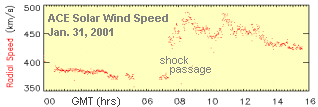|   SPACE WEATHER SPACE WEATHER
Current
Conditions
Solar Wind
velocity: 435.6 km/s
density:3.3 protons/cm3
explanation | more data
Updated: Today at 2246 UT
X-ray Solar Flares
6-hr max: C3 1710 UT Feb01
24-hr: C5 0710 UT Feb01
explanation | more data
Updated: Today at 2245 UT
Daily Sun: 01 Feb '01 
None of the sunspots in this white light image have magnetic fields more complex than beta-class. Forecasters do not expect much solar flare activity during the next 48 hours.
Sunspot Number: 130
More about sunspots
Updated: 31 Feb 2001
Radio Meteor Rate
24 hr max: 41 per hr
Listen to the Meteor Radar!
Updated: 31 Jan 2001 Interplanetary Mag. Field
Btotal: 5.9 nT
Bz: 2.7 nT south
explanation | more data
Updated: Today at 2247 UT Coronal Holes:

A coronal hole may be forming just south of active region 9330. The hole could send a solar wind stream toward Earth when it passes the Sun's central meridian early next week. . Image credit: SOHO Extreme UV Telescope.
More about coronal holes
 SPACE WEATHER SPACE WEATHER
NOAA
Forecasts
Solar Flares: Probabilities for a medium-sized (M-class) or a major (X-class) solar flare during the next 24/48 hours are tabulated below.
Updated at 2001 Feb 01 2200 UT
| FLARE | 24 hr | 48 hr | | CLASS M | 35 % | 35 % | | CLASS X | 05 % | 05 % |
Geomagnetic Storms: Probabilities for significant disturbances in Earth's magnetic field are given for three activity levels: active, minor storm, severe storm
Updated at 2001 Feb 01 2200 UT Mid-latitudes | 24 hr | 48 hr | | ACTIVE | 25 % | 25 % | | MINOR | 05 % | 05 % | | SEVERE | 01 % | 01 % |
High latitudes | 24 hr | 48 hr | | ACTIVE | 25 % | 25 % | | MINOR | 05 % | 05 % | | SEVERE | 01 % | 01 % |
| What's Up in Space -- 1 Feb 2001
Subscribe to Space Weather News! ALL QUIET: At present, none of the active regions on the Sun's visible disk pose a particularly serious threat for powerful eruptions. Forecasters expect solar and geomagnetic activity to continue low through the end of this week. IMPACT! An interplanetary shock wave hit Earth's magnetosphere Wednesday morning at ~0800 UT (midnight PST) and triggered a G1-class geomagnetic storm. Sky watchers in Canada and Alaska who were outdoors during the period of greatest activity, between 0800 and 1200 UT, likely saw aurora borealis.  The shock wave was the leading edge of a solar coronal mass ejection, described below. HALO CME: On Jan. 28th at 1600 UT sunspot group 9313 unleashed an M2-class solar flare and a brilliant coronal mass ejection (CME). Although the brightest part of the CME billowed away from the Sun's western limb (and away from our planet), SOHO coronagraphs revealed a faint halo component, the telltale sign of Earth-directed material. [See the 300 kb CME movie] WEB LINKS: NOAA FORECAST | GLOSSARY | SPACE WEATHER TUTORIAL | LESSON PLANS | MORE NEWS | BECOME A SUBSCRIBER |
 - TOTAL LUNAR ECLIPSE: On Jan. 9, 2001, the full Moon glided through Earth's copper-colored shadow. [gallery]
- CHRISTMAS ECLIPSE: Sky watchers across North America enjoyed a partial solar eclipse on Christmas Day 2000 [gallery]
- LEONIDS 2000: Observers around the globe enjoyed three predicted episodes of shooting stars. [gallery]
 | On January 19th the University of Arizona Spacewatch program spotted a new Earth-approaching asteroid, 2001 BK41. The ~3 km-wide space rock, which follows a 2.8 year orbit stretching from the inner solar system (between Earth and Venus) to the asteroid belt, poses no immediate threat. Our next close encounter with 2001 BK41 will take place in 2094 when it passes 8 lunar distances from Earth. If current orbital calculations are correct, the asteroid can never come closer than 6 lunar distances from our planet. [3D orbit] |  Jan. 25, 2001: Earth's Invisible Magnetic Tail -- NASA's IMAGE spacecraft, the first to enjoy a global view of the magnetosphere, spotted a curious plasma tail pointing from Earth toward the Sun. Jan. 4, 2001: Earth at Perihelion -- On January 4, 2001, our planet made its annual closest approach to the Sun. Dec. 29, 2000: Millennium Meteors -- North Americans will have a front-row seat for a brief but powerful meteor shower on January 3, 2001. Dec. 28, 2000: Galileo Looks for Auroras on Ganymede -- NASA's durable Galileo spacecraft flew above the solar system's largest moon this morning in search of extraterrestrial "Northern Lights" Dec. 22, 2000: Watching the Angry Sun -- Solar physicists are enjoying their best-ever look at a Solar Maximum thanks to NOAA and NASA satellites. Dec. 18, 2000: Ursid Meteor Surprise -- The normally meek Ursid meteor shower could surprise sky watchers with a powerful outburst on Dec 22nd. Dec. 8, 2000: The Baffling Geminid Meteor Shower -- Most meteor showers are caused by comets, but the Geminids, which peak on December 13th, seem to come from a curious near-Earth asteroid. Nov. 22, 2000: A Solar Flare Stuns Stardust -- Earlier this month an intense solar radiation storm temporarily blinded NASA's Stardust spacecraft en route to comet Wild-2. Nov. 21, 2000: Leonids Galore -- Find out what happened during the 2000 Leonids meteor shower. Nov. 7, 2000: Much Ado about 2000 SG344 -- In 2071 a relic of NASA's earliest space exploration efforts might return to Earth, if current estimates are confirmed. Oct. 26, 2000: Lunar Leonids -- On Nov. 17, 2000, the moon will plow through a stream of debris from comet Tempel-Tuttle. Oct. 10, 2000: The Moonlit Leonids 2000 -- Our planet is heading for a minefield of cosmic dust streams laid down by periodic comet Tempel-Tuttle. The result could be a series of meteor outbursts on Nov. 17 and 18, 2000. MORE SPACE WEATHER HEADLINES |



